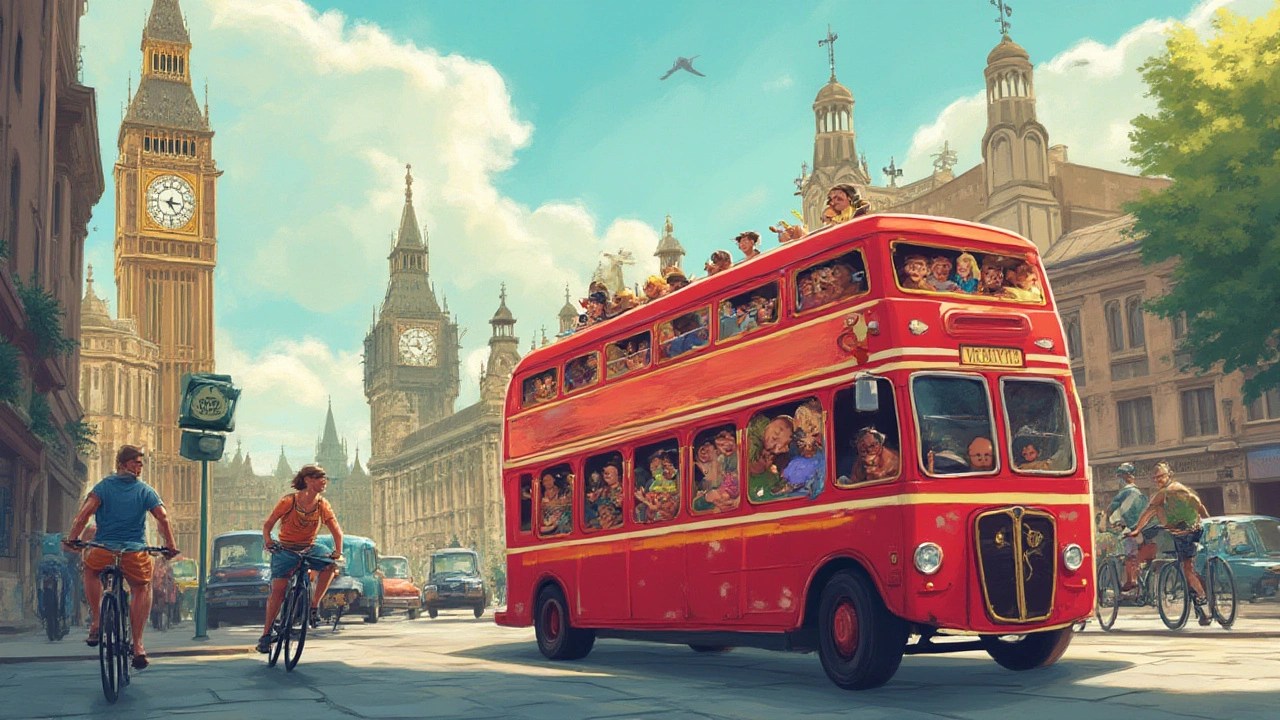You step out of the arrivals gate in Heathrow or maybe hop off the Eurostar at St Pancras, wide-eyed, ticket in hand, energy bubbling to explore. The UK looks small on a map, but ask anyone who’s zig-zagged from the Scottish Highlands to Cornish beaches—it’s full of surprises and choices. Getting around here isn’t just about going from A to B; it’s about how the journey weaves into the magic of your trip. Is it classic train journeys, budget coach rides, cheeky little hire cars, or a wild mix? A UK adventure depends on smart moves and knowing the quirks—plus a few hacks locals won’t always tell you.
The Romance and Practicalities of UK Train Travel
The UK’s railways are legendary, and honestly, there’s something almost cinematic about rolling past lush fields, ancient church spires, and cozy villages. Trains here aren’t just fast—they’re iconic. You’ll find direct, high-speed lines connecting cities like London, Edinburgh, York, Liverpool, and Manchester. Virgin-era tilting trains (now Avanti West Coast) whistle between London and the North, with some journeys from London to Manchester taking barely two hours. Even Harry Potter’s Hogwarts Express owes its fame to the West Highland Line between Glasgow and Mallaig—one of the world’s most scenic train rides.
Is train travel expensive? If you buy last-minute, yes, sometimes jaw-droppingly so. But the trick is to plan ahead. UK rail tickets go on sale 8-12 weeks in advance and buying ‘Advance’ fares online from official operators or at National Rail Enquiries can slash prices to a third. For flexibility, look at ‘Off-Peak’ tickets, but memorize the fine print on timing to dodge extra charges. Consider a BritRail Pass or the Two Together Railcard if you’re traveling with someone—these can save up to a third off fares. Families can get a Family & Friends Railcard (up to four kids ride at 60% off with two adults).
Station stops are destinations in themselves—King’s Cross isn’t only a Harry Potter pilgrimage; Bath Spa sits steps away from ancient Roman ruins and steam-filled spas. Many smaller villages have picture-perfect stations where half the charm is just watching the countryside drift past as you nibble on a Cornish pasty.
Fast fact: The UK rail network covers over 16,000 km and records about 1.7 billion passenger journeys a year (Office of Rail and Road, 2024). Trains are electrified in many areas, so it’s a greener way to travel than you might think. A lot of city-to-city trains have reliable WiFi, power points, air-conditioning, and food trolleys with everything from tea to surprisingly good sausage rolls.
But mind the quirks: Strikes are headline news lately. Always check ahead for engineering works, especially on weekends, and take note that last trains tend to leave earlier than you might expect, especially outside London. If you’re heading far north or into Wales, trains get less frequent, so plan accordingly.
If you’re ready to see the best of Britain from your seat, trains just might be the dream—and the journey itself is half the fun.
Coaches, Buses, and the Beauty of Budget Rides
If your wallet would rather buy souvenir fudge than shell out on fancy trains, coaches and buses make it ridiculously easy to see the UK on a budget. National Express and Megabus are the big players, running comfortable coaches between most towns and cities—for as little as £3 if you pounce on a flash sale ticket. Even late bookings are way cheaper than rail. The catch? Coaches usually take double or triple the time of trains—and occasionally smell like cheese toasties long forgotten in a backpack.
Onboard, you get WiFi, charging ports, air conditioning, and reserved seats. Multiple daily departures mean fewer worries about missing the one-and-only coach. For night owls, overnight services cut hotel bills—just pack a neck pillow and some good playlists for those long stretches of motorway at 3 a.m.
Local buses are legendary for getting you right to the offbeat stuff. Double-deckers are a slice of British culture all by themselves (yes, sit up top in the front for the views and skip filling in bus trivia at your next pub quiz). Buses reach hundreds of spots where trains don’t venture—think Dartmoor villages, windswept Highland towns, and seaside gems like Whitby or Tenby. Just bring patience: rural areas sometimes only see a couple of buses per day, especially on Sundays.
It helps to download apps like ‘Bus Checker’ or check real-time info on Traveline. Many city buses now use contactless payment, but it pays to check in advance—some smaller places still want coins.
Here’s a quick bus and coach comparison table:
| Service | Cost (Sample UK Run) | Journey Time | Flexibility |
|---|---|---|---|
| Train (London-Edinburgh) | £45-£150 | 4.5 hours | Medium |
| Coach (London-Edinburgh) | £15-£40 | 8-10 hours | High |
| Local Bus (Rural) | £2-£5 | Varies | Low |
| City Bus (Day Ticket) | £3-£6 | N/A | High |
Buses and coaches let you slow down, meet locals, and really see the landscape, potholes and all. For visitors who don’t want to fuss with parking or just want the cheapest way around, this route is clear. Frequent travelers—especially families—will find multi-ride or day passes can be real money-savers.

Hitting the Open Road: The Freedom of Self-Drive
Sometimes you just want to follow your own timetable, swerve off the tourist trail, or drag a beach tent and half your kid’s toys in the boot. That’s when hiring a car (or campervan) makes perfect sense. Even if the UK’s famously left-hand driving is a bit nerve-wracking at first, you quickly get into the rhythm, and suddenly that ruined castle down a side road is yours to explore—without relying on timetables.
Car hire outfits are everywhere: airports, city centers, smaller towns, sometimes even delivered to your hotel door. Big brands like Enterprise, Hertz, and Europcar feel familiar, but local specialists occasionally deliver better deals or more flexible drop-off points. Most UK rental cars are manual (stick shift), so book an automatic early if that’s your jam—it costs more, but you won’t be hunted by the local driving instructor’s ghost when you forget the clutch.
Parking in big cities like London, Edinburgh, or York is thread-the-needle expensive, so ditch the car during long city stays and use public transport there. The sweet spot is using a car to reach national parks (Peak District, Lake District, Snowdonia), ancient stone circles wedged into sheep fields, or sandy coves in Cornwall and the Welsh coast.
Fuel costs sting a little: as of July 2025, unleaded hovers around £1.65 per litre (that’s roughly £6.25 a US gallon). But carpooling—especially with kids—can save everyone the headache of constant luggage-hauling. And for the road trip obsessed, the UK’s scenic drives deliver: the North Coast 500 in Scotland, Yorkshire’s moorland loops, or the A39 for hidden gems in Devon and Cornwall.
- Tip: Tolls are rare but keep a credit/debit card handy for spots like London’s Congestion Charge, the Dartford Crossing, or the Severn Bridge.
- Satnav rentals are pricey. Download Google Maps offline for coverage everywhere, even in the spooky hills behind Loch Ness.
- Legal tip: Brits take drink-driving seriously. The limit is lower than in much of North America—don’t risk it.
- Sightseeing from the car? Many villages have tiny, winding roads—slow down, pull in at passing areas, and always watch for sheep and cyclists.
Campervans have boomed since 2020, and for families or those chasing total flexibility, a modern rental gives you the run of scenic campsites, wild views, and breakfast with a castle outside your window. Just book sites in advance—spontaneity is tricky in peak summer and school holidays.
Driving here isn’t about speed. Motorways are smooth and efficient, but the magic happens once you head onto the B-roads or let the journey get a little lost. For adventures beyond the guidebooks, four wheels are often your best friend.
Unconventional Ways to See the UK: Ferries, Biking, and Walking Trails
There’s more to getting around the UK than just trains, coaches, and cars. The islands, waterways, and backcountry trails promise whole new adventures if you’re up for something different. If you’ve got a wild streak, or just want to escape crowds, grab your hiking boots or a ticket for the open seas.
Ferries are the lifelines to dozens of magical spots. Want to hit the Isle of Skye, Orkney, or Isle of Wight? CalMac and Wightlink run reliable ferry services with views that make you forget the world. Some crossings are barely 10 minutes; others last hours, letting you spot seals, seabirds, and even dolphins near Scottish waters. Vehicles go with you if you drive on, but you can rock up as a foot passenger for a fraction of the price. One tip—book ahead in summer; crossings do sell out, and weather can cancel runs last minute.
Biking is getting a second wind in Britain. Over 16,000 miles (about 25,700 km) of National Cycle Network snake from city riversides to country lanes. London’s cycle hire scheme—Santander Cycles—makes exploring the capital easy, and further north, dedicated cycleways connect gems like Oxford, Stratford-upon-Avon, and Cambridge. Long-distance classics (C2C, Hadrian’s Cycleway) let you pedal from coast to coast, pit-stopping at real local pubs and snacking on fresh-baked scones. If you’re not Lance Armstrong, e-bikes are everywhere and flatten out even the meanest Yorkshire hills.
The UK is, at its heart, a walker’s paradise. The public ‘right of way’ system unlocks countless trails that cross private land—an odd British quirk but a beautiful one. Trails like South West Coast Path, Offa’s Dyke, the Pennine Way, and Ridgeway give you scenery Instagram can’t do justice. Waymarked footpaths lead past standing stones, ruined abbeys, and wildlife-rich reserves. Tackle a bit or go big—accommodation on these routes ranges from hostels and B&Bs to cozy country inns with muddy boots welcome at the bar.
Here’s a quick glance at these alternative travel modes:
| Mode | Example Route/Usage | Cost | Who’s it for? |
|---|---|---|---|
| Ferry | Oban to Mull (Scotland) | £7-£35 | Island hoppers |
| Biking | London to Cambridge | £2-£30/day (bike hire) | Cyclists, families |
| Walking | South West Coast Path | Free | Hikers, ramblers |
Six-year-olds and seniors alike are seen marching through puddles or picnicking beside stone bridges—Britain almost insists you live outdoors at least part of your trip, weather be damned. Pack light layers, accept the drizzle, and let chance encounters—a chatty hilltop walker, a sheepdog tumbling out of a hedge—become your favorite souvenirs. Londoners and Yorkshire folk alike will agree: There’s no such thing as the wrong choice, only the wrong shoes.
So if the regular travel routes start to feel too familiar, don’t be afraid to get creative. Some of the best stories you’ll tell will come from the journeys nobody else planned.
